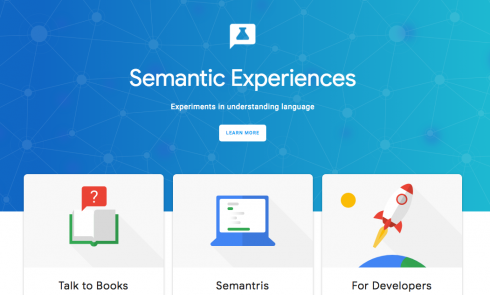
In an effort to showcase the evolution of natural language understanding, Google is launching Semantic Experiences to highlight some examples of what is possible with artificial intelligence. Natural language understanding is a type of artificial intelligence that focuses on machine reading comprehension.
“Natural language understanding has evolved substantially in the past few years, in part due to the development of word vectors that enable algorithms to learn about the relationships between words, based on examples of actual language usage. These vector models map semantically similar phrases to nearby points based on equivalence, similarity or relatedness of ideas and language. Last year, we used hierarchical vector models of language to make improvements to Smart Reply for Gmail. More recently, we’ve been exploring other applications of these methods,” the Google Research team wrote in a post.
Semantic Experiences will highlight two examples of natural language understanding: Talk to Books and Semantris. In addition, Google is providing its recently published Universal Sentence Encoder, which details the models used in the examples, and a pre-trained semantic TensorFlow module that allows the community to play around with their own sentence and phrase encoding.
Talk to Books is a way of exploring books at the sentence level, instead of at the author or topic level, Google explained. It allows the user to ask a question or make a statement, and then it will find sentences in books that respond to that question or statement. The tool is not dependent on keyword matching. According to Google, it is a good way of “talking” to books and the responses can help you determine if you’re interested in reading them.
The models used in this application were trained on roughly one billion conversation-like sentences. This allows the tool to be able to identify what good responses would be. Once you state your question, it searches more than 100,000 books to determine the ones that respond best to your statement.
Google still believes the program has room for improvement. Since it works at the sentence level, sentences can be taken out of context, providing unexpected results.
Semantris is a word association game that uses machine learning. It provides a list of words and then has you enter a word. It then ranks the other words on the screen and tries to determine the word you were thinking of when you entered your word. For example, if the words include “refrigerator,” “neighbor,” “hat,” “ear,” and “telephone,” and you enter “talking,” it will guess telephone.
It features a time-based Arcade version and a Blocks version that has no time pressure.
“The examples we’re sharing today are just a few of the possible ways to think about experience and application design using these new tools. Other potential applications include classification, semantic similarity, semantic clustering, whitelist applications (selecting the right response from many alternatives), and semantic search (of which Talk to Books is an example). We hope you’ll come up with many more, inspired by these example applications. We look forward to seeing original and innovative uses of our TensorFlow models by the developer community,” the team wrote.






